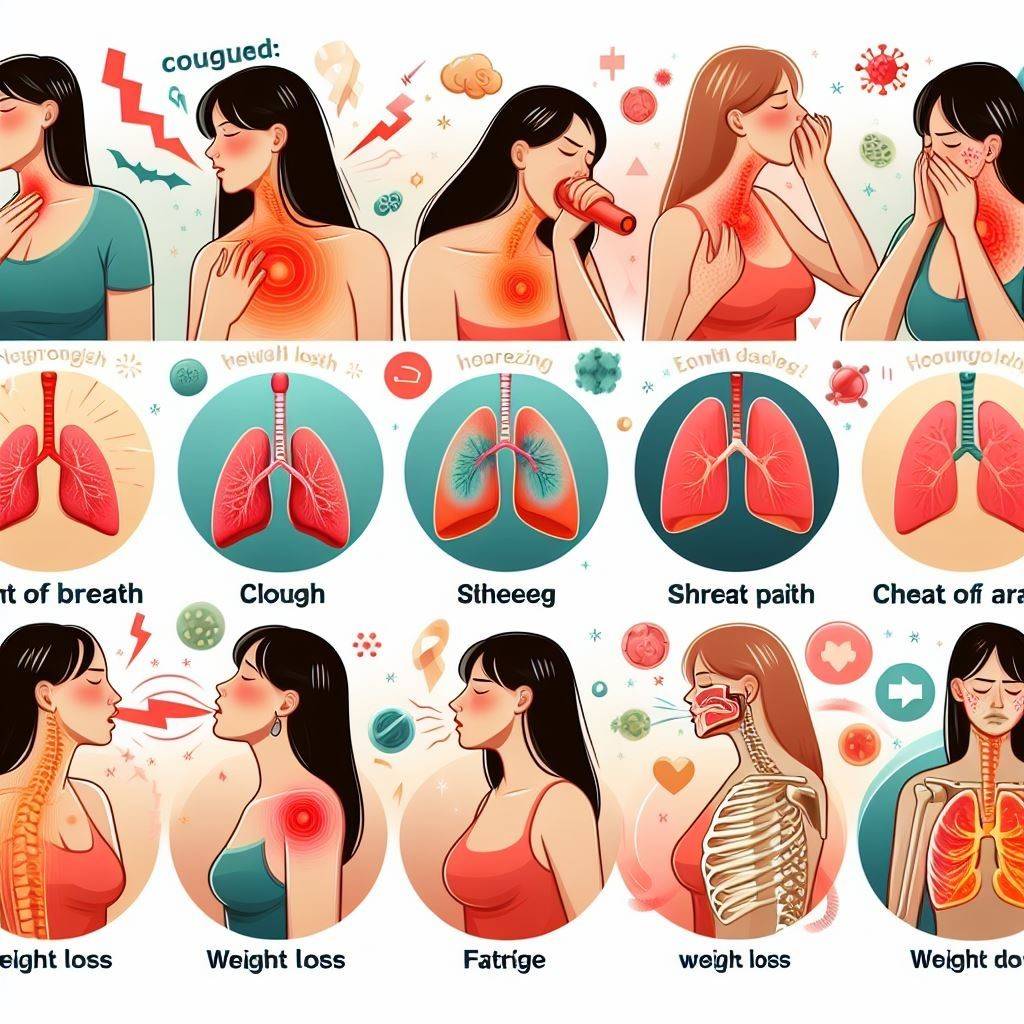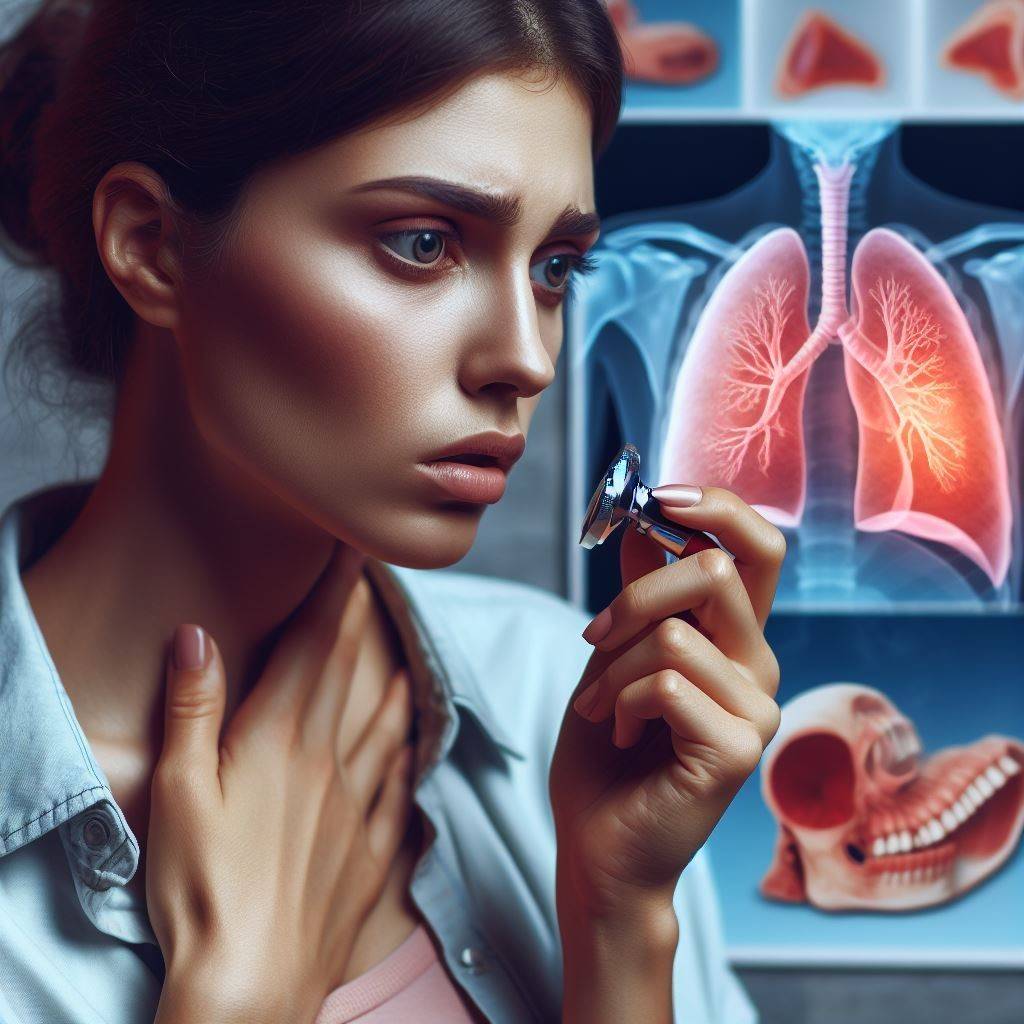Learn about the subtle symptoms of lung cancer in women. Uncover the silent signs that could indicate a serious health concern.
Introduction
Greetings, dear readers! Today, we’re embarking on a journey of knowledge and awareness, delving deep into “Symptoms of Lung Cancer in Women.” Let’s explore the subtleties that often escape our notice, understand their significance, and empower ourselves to take charge of our health.
Understanding Lung Cancer: A Brief Overview
Lung cancer is a formidable adversary that affects both men and women, but it’s essential to recognize that it can manifest differently in each gender. Women may experience symptoms that are unique to their biology and physiology. By being attuned to these nuances, we can catch the signs early and improve our chances of successful intervention.
Symptoms of Lung Cancer in Women

1. Persistent Cough that Lingers
Imagine this: you’ve had a persistent cough for weeks, and won’t fade away. This isn’t your typical seasonal cough; it’s a persistent companion that lingers, resistant to usual remedies. Such a cough should raise a flag of concern. Lung cancer often manifests with a stubborn cough, sometimes accompanied by blood in the sputum. If you find yourself trapped in this coughing cycle, it’s time to seek medical evaluation.
2. Shortness of Breath: Not Just Another Day
In a bustling world, we’re often left breathless – after a jog, a hearty laugh, or climbing a few flights of stairs. But when shortness of breath becomes a constant companion, affecting even mundane activities, it’s a signal worth heeding. This breathlessness might be accompanied by a wheezing or a feeling of tightness in the chest. Your body could be hinting at an underlying issue, and addressing it promptly is paramount.
3. Chest Pain: A Warning Bell
Chest pain isn’t something to take lightly. While it could stem from various causes, persistent or worsening chest pain should never be ignored. It might feel like aching, discomfort, or pressure in the chest. This symptom warrants immediate medical attention to rule out serious conditions like lung cancer.
4. Unexplained Weight Loss: A Clue to Uncover
Weight loss, especially when you haven’t intentionally altered your diet or exercise routine, can be puzzling. Shedding pounds without trying might sound appealing, but it can also be a sign of an underlying health issue. When coupled with other symptoms, unexplained weight loss could point toward the need for medical assessment.
5. Hoarseness and Voice Changes
Your voice is your unique signature, but what happens when it begins to change without an apparent reason? Hoarseness or noticeable changes in your voice might be attributed to various factors, including lung cancer. If these voice alterations persist, consider it a call to investigate further.
6. Chronic Fatigue: Beyond Everyday Tiredness
Fatigue is a part of life, especially in today’s fast-paced world. However, if fatigue becomes your constant companion, lurking even after an entire night’s sleep, it’s time to delve deeper. Lung cancer can zap your energy and leave you feeling perpetually tired. Don’t brush off chronic fatigue – let it prompt you to seek answers.
7. Mysterious Aches and Pains
Aches and pains are a natural part of the human experience, but when they persist without a clear cause, it’s worth exploring further. Lung cancer can cause discomfort in various parts of the body, so it’s wise to connect with a healthcare professional if you’re dealing with unexplained aches.
8. Changes in Finger Appearance: Clubbing
Let’s talk about clubbing – not the dancing kind, but changes in your fingers. If you notice your fingertips becoming enlarged and rounder, it could be an indication of clubbing. This phenomenon is often linked to decreased oxygen levels in the blood, which can be associated with lung conditions, including lung cancer.
9. Repeated Infections: An Unwelcome Pattern
While infections are a part of life, repeated and persistent infections can be a sign that something isn’t right within your immune system. Lung cancer can weaken your body’s ability to fight off infections, so if you find yourself frequently falling ill, it’s time to explore the underlying cause.
10. Listen to Your Gut Feeling
Intuition may be more persuasive than rational thought at certain moments. Don’t put off seeing a doctor if you’ve been having concerns about your health. You may play a crucial role in early identification and intervention if you trust your instincts and take a proactive approach.
Finally, our health is the most important thing in the broad scheme of things. When we learn to recognize these subtle signs, we become more than passive viewers; we become active players in our health. The key to successful treatment and better results is early identification.
Never think twice about seeing a medical professional; doing so demonstrates your strength of character and dedication to maintaining your health and vitality. Symptoms of Lung Cancer in Women, the unspoken signals are there and may be interpreted. Let’s accept our calling as health advocates and face any opposition head-on as a unified front.
Diagnosis of Lung Cancer in Women: A Clear Path Ahead
Hello there, curious minds! Today, we’re on a quest to explore the Symptoms of Lung Cancer in Women and demystify the diagnosis process. Let’s break it down into simple steps that lead us to clarity.
1. Starting Strong: Your Story Matters
It all begins with your story. Your healthcare provider listens carefully to your medical history and symptoms to start the diagnostic journey.
2. Close Look: The Physical Exam
A thorough physical exam helps your doctor observe any telltale signs that could point to lung cancer.
3. Seeing Inside: Imaging Tests
Special scans like X-rays, CT, MRI, and PET scans give us a peek inside, revealing what’s happening in your lungs.
4. Tissue Truth: The Biopsy
When needed, a biopsy collects tiny samples from your lung for closer examination under a microscope.
5. Expert Clues: Pathology and Staging
Pathologists study these samples to confirm if it’s cancer. Staging helps understand its extent.
6. Treatment Talk: Collaborative Care
A team of experts discusses your case and crafts a personalized treatment plan, considering surgery, chemo, radiation, and more.
7. Facing It: Treatment Options
With a clear diagnosis, you and your team explore treatment choices that suit your situation best.
8. Support System: Emotional Well-being
Diagnosing lung cancer can be tough emotionally. Seek support from loved ones and professionals to navigate this journey.
Risk Factors for Lung Cancer in Women: Know Your Vulnerabilities
Hey there, curious souls! Let’s talk about the factors that can increase women’s chances of lung cancer. It’s a quick dive into the key things you should be aware of:
1. Smoking Matters: The Big One
Lighting up or being around smokers boosts the risk – it’s that simple. Tobacco smoke does no favors to your lungs.
2. Sneaky Radon: Home Intruder
Radon gas creeping from the ground into homes can be a problem. Testing and tackling it is a smart move.
3. Job Hazards: On-the-Job Dangers
Some workplaces expose you to nasty stuff like asbestos. This can heighten your lung cancer risk, so be cautious.
4. Family Story: Genes in Play
Family history of lung cancer? Your risk might go up. Genetics can have a say, but shared habits matter too.
5. Hormone Hints: Hormone Therapy Caution
Hormone replacement therapy (HRT) during menopause could nudge risk, especially if you don’t smoke.
6. Air Quality: Pollution Problems
Breathing dirty air isn’t successful in your lungs – it could raise lung cancer risk.
7. Past Battles: Watchful Eye
If you’ve fought lung cancer before, be on the lookout. It might come knocking again.
8. Lifestyle Choices: Your Call
What you eat and how active you are to play a role. Healthy habits lower the risk.
9. Lung Issues: Chronic Concerns
Trouble like COPD weakens defences, making lung cancer a potential threat.
Wrapping Up: Awareness is Power
And there you have it, your cheat sheet on lung cancer risk factors. Being in the know puts you ahead – keep an eye out for risks and stay lung-smart!
Treatment for Lung Cancer in Women
Greetings, dear readers! Today, we’re embarking on a journey to explore the Symptoms of Lung Cancer in Women, as well as the treatment options available. Join me as we navigate the diverse landscape of therapies and interventions that work together to combat this complex condition.
1. Surgical Solutions: Removing the Threat
Surgery can be a powerful tool in the fight against lung cancer. Depending on the stage and location of the tumor, different surgical approaches may be considered:
- Lobectomy: Removing a portion of the lung where the tumor is located.
- Pneumonectomy: Removing the entire lung.
- Wedge Resection: Removing a small section of the lung with the tumor.
- Segmentectomy: Removing a larger section of the lung than a wedge resection, but not the entire lobe.
2. Radiation Therapy: Targeted Energy
Radiation therapy uses high-energy rays to target and destroy cancer cells. It can be delivered externally or internally (brachytherapy), and is often used alongside surgery or chemotherapy to increase effectiveness.
3. Chemotherapy: Systemic Assault
Chemotherapy involves powerful medications that circulate through your body, targeting and killing rapidly dividing cancer cells. While it can have side effects, it’s a key player in controlling and shrinking tumors.
4. Targeted Therapy: Precision Strikes
This newer approach focuses on specific genetic changes in cancer cells. Targeted drugs interfere with these changes, slowing down or blocking the growth of tumors.
5. Immunotherapy: Empowering Your Defense
Immunotherapy boosts your immune system’s ability to recognize and attack cancer cells. It’s like giving your body an extra push in the battle against lung cancer.
6. Clinical Trials: Pioneering Progress
Participating in clinical trials can offer access to cutting-edge treatments that are still in development. It’s a chance to contribute to medical advancements while receiving effective therapies.
7. Palliative Care: Quality of Life Matters
Palliative care focuses on improving your quality of life and managing symptoms. It’s not just about physical well-being; emotional and psychological support is also integral.
8. Complementary and Alternative Therapies: A Holistic Approach
Some individuals explore complementary therapies like acupuncture, massage, or meditation to complement conventional treatments. These therapies can enhance well-being and provide emotional comfort.
Conclusion about Symptoms of Lung Cancer in Women
In the grand journey of life, our health takes center stage. By familiarizing ourselves with these subtle symptoms, we’re not just observers but active participants in our well-being. Early detection is a key that unlocks the door to effective treatment and improved outcomes. Remember, seeking medical guidance isn’t a sign of weakness – it’s a testament to your commitment to living a healthy, vibrant life. The silent signs are there, waiting to be deciphered. Let’s embrace our role as health advocates and stand united against the challenges that may arise.
Hello there, curious minds! Today, we’re on a quest to explore the Symptoms of Lung Cancer in Women, as well as the treatment options available. Keep the lines of communication open with your healthcare team, and never underestimate the power of knowledge. With awareness as our compass, we navigate the path ahead with confidence, resilience, and a deep-rooted commitment to our health and happiness. Let’s break it down into simple steps that lead us to clarity.
Reference
NHS. (2021). Lung Cancer Symptoms.
https://www.nhs.uk/conditions/lung-cancer/symptoms/



